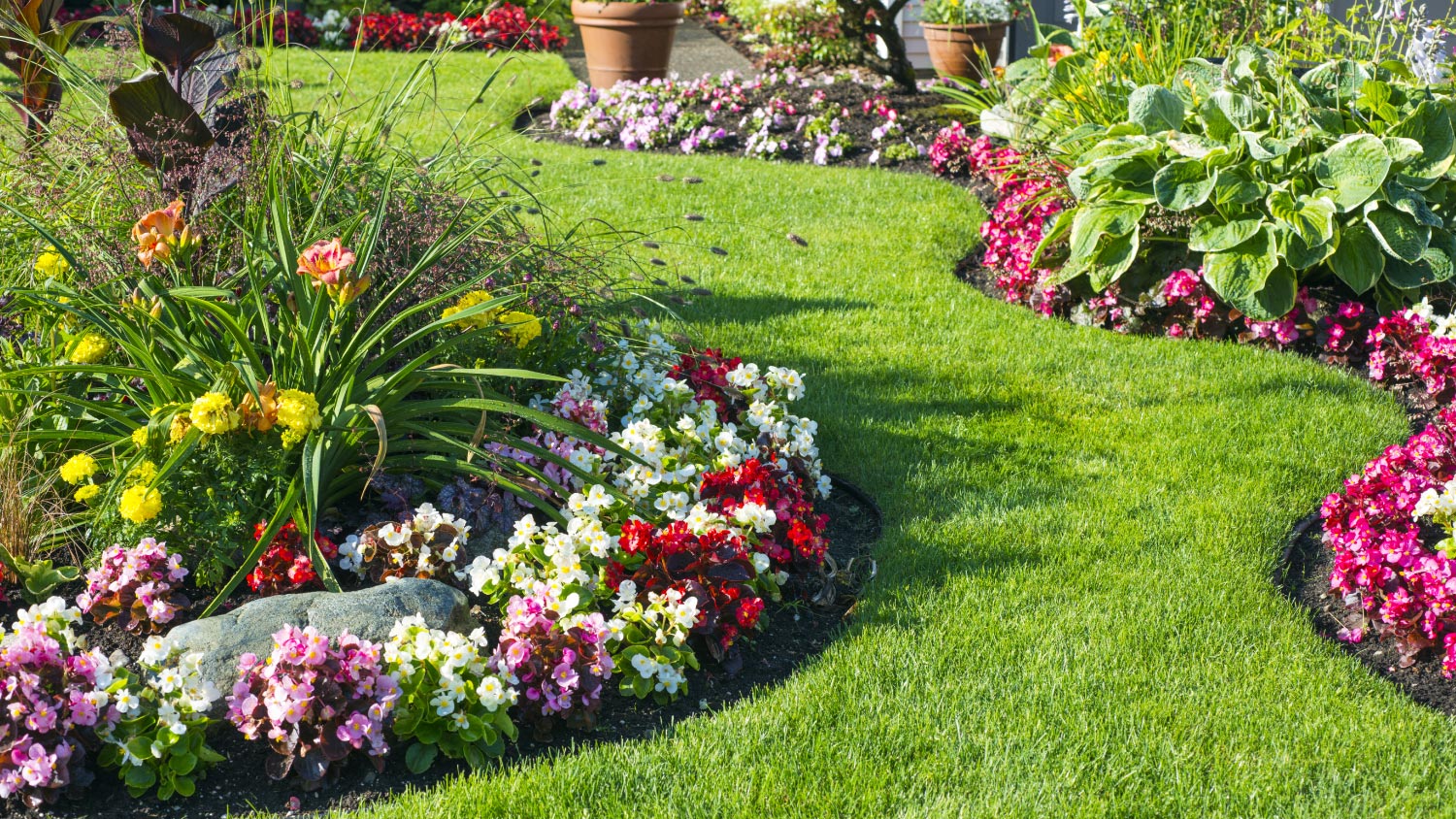
Edging has a multitude of benefits in garden landscapes. It can effectively blend different elements within the design, define specific areas, ensure a neat border, and improve the space’s overall aesthetic. It also has practical advantages by providing a barrier between lawns and flower, gravel, or mulch border and helps stop weeds from creeping into flower beds.
There are many different types of landscape edging, and design possibilities are endless. What you select will depend on your desired aesthetic, practical applications, and budget. Check out these creative garden edging ideas if you’re looking for inspiration.
1. Corten Steel Curves

Photo: Courtesy of Aga Tomaszek
Corten steel is arguably the most on-trend, contemporary garden edging option right now. It’s durable, low-maintenance, and eye-catching. Aga Tomaszek (@thishousewemade) uses it to great effect in her impressive self-made, cozy, tropical-vibes backyard. The curved, sweeping lawn edging also contrasts beautifully with the pebble pathway.
2. Edgy Shade Plants
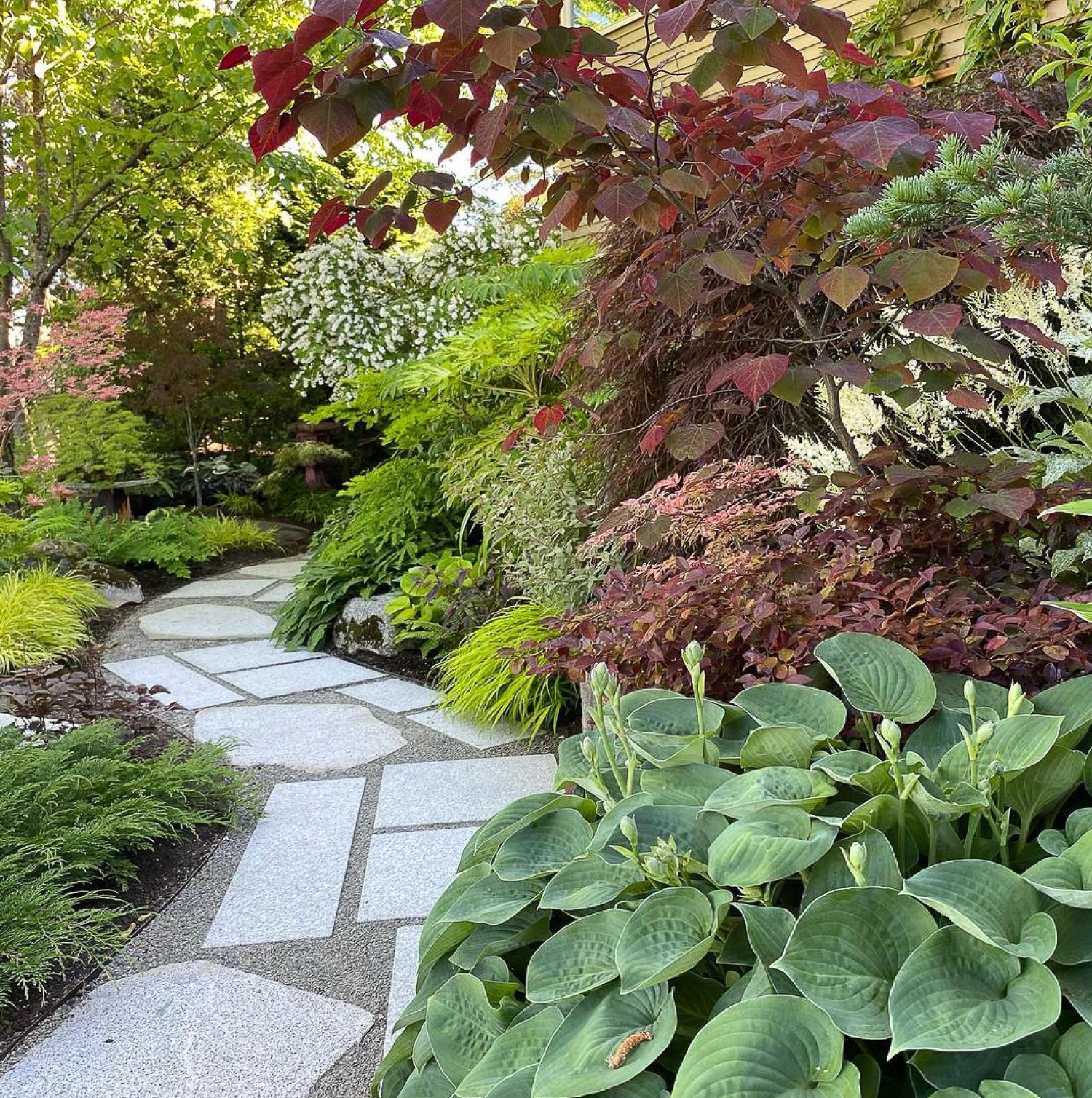
Photo: Courtesy of Camille Paulsen
Camille Paulsen (@tahomaflora) has designed a striking side garden. Shade-loving plants and shrubs with abundant foliage edge the curved pathway. This creates effective contrasting texture and colors.
3. Year-Round Interest With Ornamental Grasses

Photo: Courtesy of Henry
If you’re looking to add a more natural, softer feel to your garden edges, why not consider planting low-maintenance ornamental grasses? And, if you pick wisely, they’ll provide lovely year-round interest. Henry (@henryhoblog) planted around 20 divisions of a single Japanese sweet flag (Acorus gramineus) clump—a few years later, they have filled out perfectly!
4. Hydrangea Hedging

Photo: Courtesy of Christiane Zorenkov
Christiane Zorenkov’s country house garden is elevated by the standout cobbled pathway edging. The large and impressively long-blooming Annabelle hydrangeas (Hydrangea arborescens ‘Annabelle‘) can flower for up to two months in the summer and sometimes even bloom again in the fall. The foliage provides year-round interest, and they’re a great choice for partial shade locations. Here they are supported by easy-to-care-for boxwood hedging.
5. Blended Border Edging
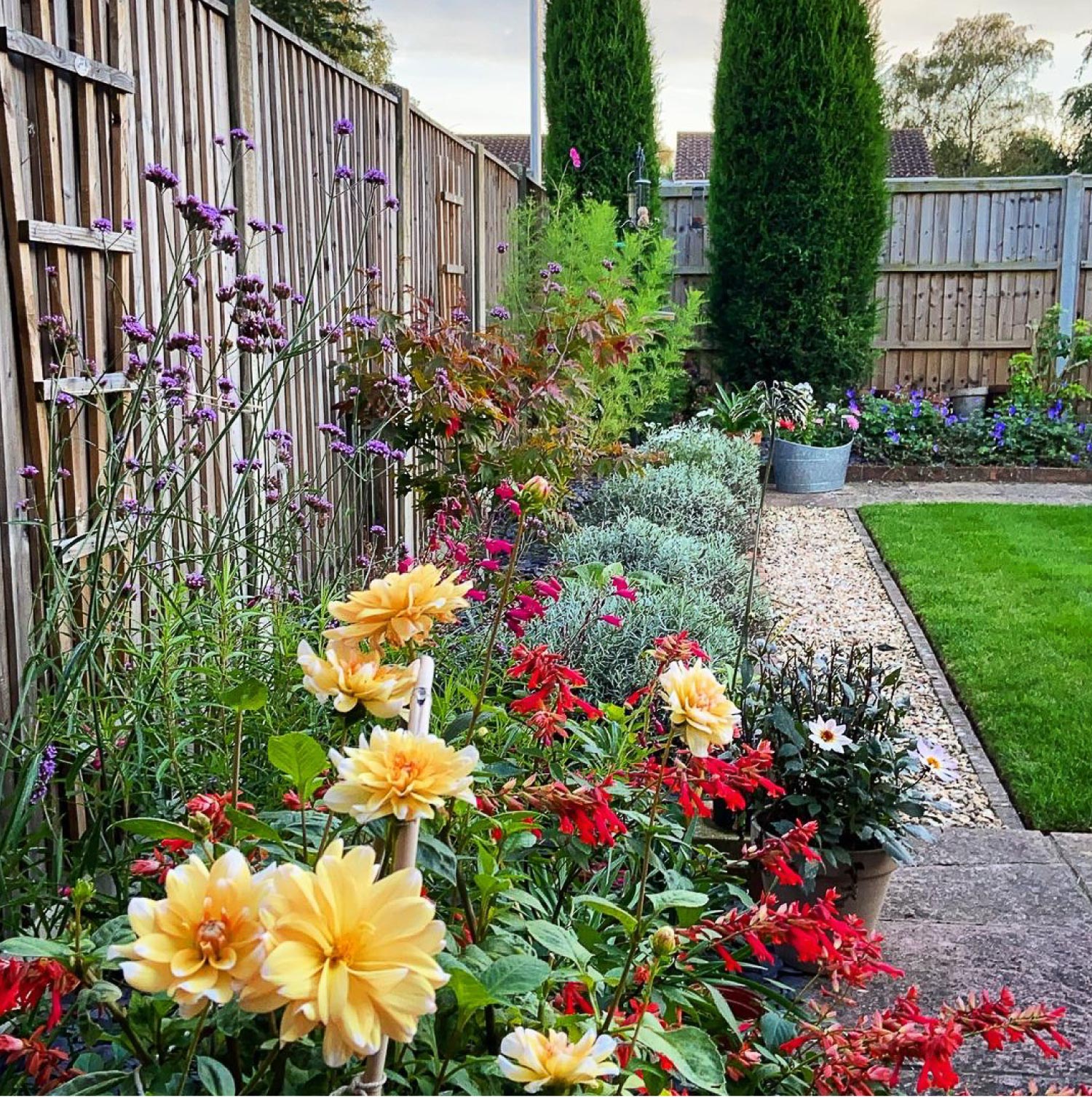
Photo: Courtesy of Jo Williams
The casual, colorful, mix of pollinator-friendly perennials in this border edging from Jo Williams (@pritchy_plants) may look unplanned, but it provides interest throughout the year. The additional pebble edging adds extra contrast against the lush, green lawn. This type of landscape edging requires more planning and maintenance than some, but the rewards make the effort worthwhile.
6. Break Up Your Backyard with Bricks

Photo: Courtesy of Lucy Taylor Garden Design
A brick edging, like this one from Lucy Taylor Garden Design, is a low-maintenance, durable, and uniform option that comes in a variety of finishes. You won’t need to worry about manually finishing your lawn edging, and bricks provide a clear border definition. If you’re looking to garden sustainably, it’s often possible to source reclaimed bricks from salvage yards.
7. Raised Beds

Photo: Courtesy of Hannah Wood
Hannah Wood’s (@atnumbereighteen) stylish renovation of her 1857 Victorian terrace extends to her backyard. The edging combines reclaimed bricks and planters made from old sleepers with standout, tall ornamental alliums that beautifully contrast with the modern, unobtrusive black fencing.
8. Concrete Curves
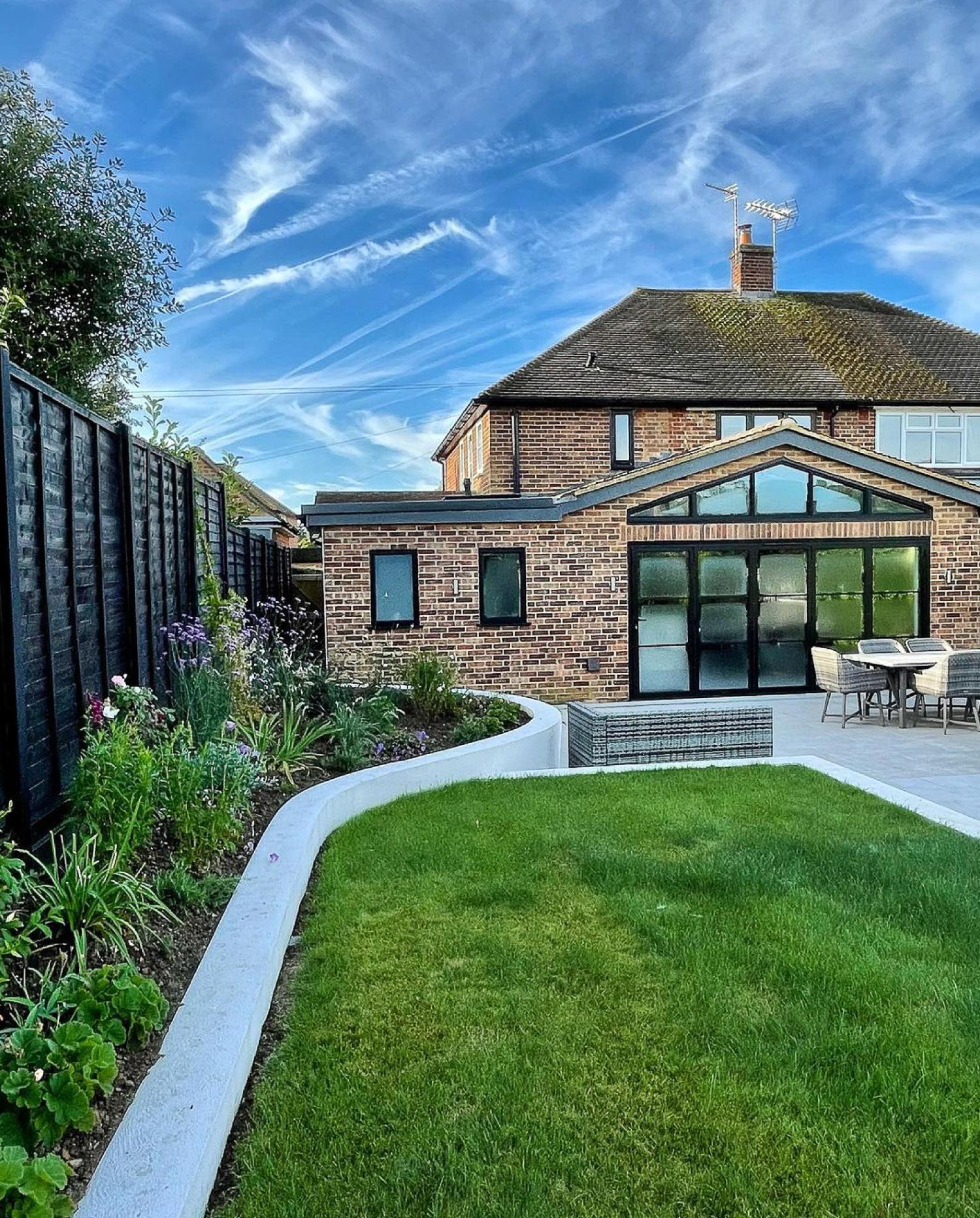
Photo: Courtesy of Helen Wilde
The clean lines of the rendered wall edging complement the mid-century modern architecture of Helen Wilder’s (@1950s_renovirgin) 1950s renovated semi. In addition, the raised bedding provides depth, texture, and interest against the contrasting fencing. The edging also blends perfectly with the durable, low-maintenance, easy-to-clean porcelain patio pavers.
9. Play Up Your Pathway

Photo: Courtesy of The Pheasant Garden
The curved center-piece pathway with brick edging in Tania’s (@thepheasantgarden) garden accentuates the lush lawn and mixed borders containing various perennial plants, shrubs, and ornamental grasses beautifully.
10. Eclectic Edges
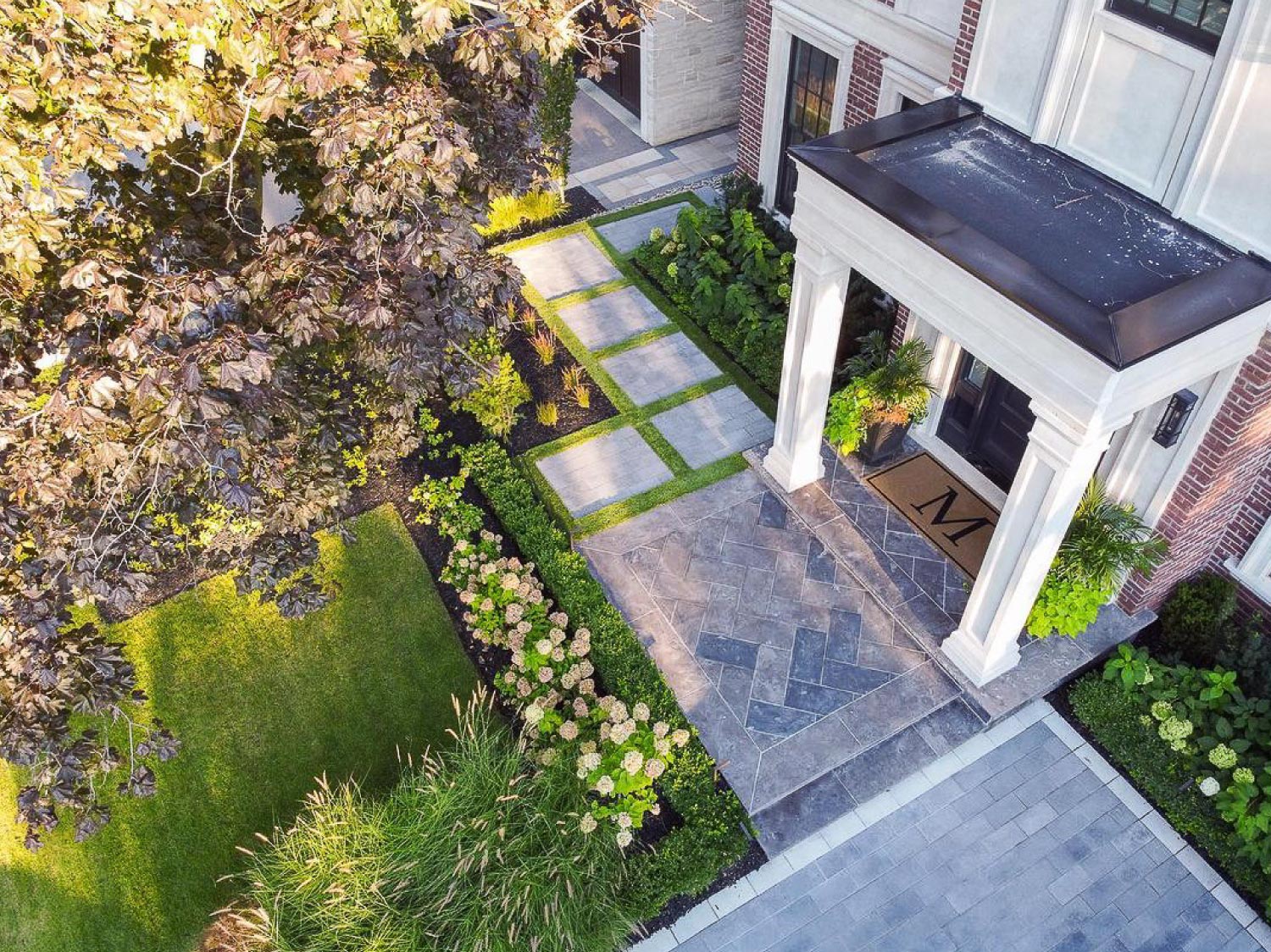
Photo: Courtesy of Taylor-Amey Design Inc
Taylor-Amey Design Inc has incorporated various edging ideas into this modern landscape design. The clean lines of the boxwood hedges, the depth, and texture of the ornamental grasses, the well-defined lawn borders, and the color from the flowering shrubs all come together cohesively.
11. Keep It Classic

Photo: Courtesy of Project Tiftuf
Lawn care specialist Project Tiftuf illustrates why sometimes traditional and simple landscape edging styles work best. This lush expanse of lawn is the star of the show, complemented by unobtrusive, neat wood edging and a pebble border. Some planters and a raised flower bed add additional interest without being unnecessarily flashy.
:strip_icc():format(webp)/flowerbed-FnaIcQqAq6V9xBgOYkh8fn-e99207dc9b5a4969bd8187e94840d362.jpeg)
PHOTO:
PETER KRUMHARDT
Create a crisp, clean design within your landscaping using edging to outline various areas of your yard. Define designated growing areas in your flower beds and vegetable gardens. These inexpensive garden edging ideas will add character and texture to landscaping. In an afternoon, you can create a rustic brick or concrete stone outline for any area using a few simple materials.
01of 08
Brick Garden Edging
:strip_icc():format(webp)/Meditation-garden-D_OuCghAap08bltrnR-4q3-3b2a04757e014f7f90526de89e5a4465.jpg)
DEGENNARO ASSOCIATES
Brick is a common garden edging idea because it’s classic, widely available, and inexpensive. Push bricks tightly together to minimize spaces between them that turf can slip through. To prevent heaving and unevenness in your garden edging, set your bricks in a bed of sand.
Editor’s Tip
If you set the brick just above the soil, you can use it as a mowing strip, running your lawn mower’s wheel over the brick. This eliminates the need for trimming.
The 19 Best Plants for Edging Flower Beds in Sunny or Shady Spots
02of 08
Diagonal Brick Garden Edging
:strip_icc():format(webp)/BluePetunia-ByQNYQkyandBYwX2FnV8Fd-40100517030e40918ac9f38a6ccece3a.jpg)
PETER KRUMHARDT
Lay old, mismatched bricks on the diagonal for a 19th-century domino effect in your garden edging. Dig a trench and add several inches of sand for drainage so the bricks don’t heave. Set the bricks in the trench, half exposed, leaning tightly one against the next, then fill in with soil. If you’re edging several garden beds, lean all the bricks in the same direction.
The 10 Best Gardening Gloves, According to Testing
03of 08
Flagstone Garden Edging
:strip_icc():format(webp)/flowerbed-FnaIcQqAq6V9xBgOYkh8fn-e99207dc9b5a4969bd8187e94840d362.jpeg)
PETER KRUMHARDT
Edging your landscaping garden beds with flagstone lends a classic look particularly well-suited to country and cottage gardens. Flagstone is available in several colors and thicknesses, so you can easily use it to coordinate or contrast your plants, other stonework in the landscape, or even stonework on your house. Irregular in shape, flagstones are durable and stack securely in the yard.
04of 08
Rock Garden Edging
:strip_icc():format(webp)/Rock-Garden-SIP861067_preview-afc6f442b23245a2a218fe5e7d32d427.jpg)
SUSAN GILMORE
Mix and match rock shapes and colors for a natural stone garden edging idea. Large multicolor rocks complement this landscape’s informal style. Positioned in a winding pattern, the round boulders allow sweet alyssum to creep over and between the rocks, creating a lacy, scalloped look in this landscaped flower bed.
Rock Gardens Ideas
05of 08
Cobblestone Garden Edging
:strip_icc():format(webp)/Garden-arbor-1JCG68C-qK2AN7_WLcp-IU-28cb1b74cc7043f783a9835c617d25c8.jpg)
EMILY MINTON-REDFIELD
Square cobbles of granite garden edging combine with a hedge of Korean boxwood to give this landscape shape. ‘Annabelle’ and oak leaf hydrangeas add billowing blooms of white, their large leaves contrasting with the textures and shapes of the paving, edging, and hedge.
06of 08
Garden Edging Idea with Plants
:strip_icc():format(webp)/Backyard-garden-0sW72tgWK5CAxrTyYEY2tR-775186b4416247cebdfbc2425f48403b.jpg)
SUSAN GILMORE
Low, mounding plants can be a fantastic landscaping garden edging idea. When planted in one long mass of draping color, low-growing plantings of sweet alyssum (shown here), veronica, bouncing bet, artemisia, coralbells, or candytuft soften hard edges and add a splash of color.
07of 08
Recycled-Bottle Garden Edging
:strip_icc():format(webp)/Bottle-garden-edging-2jxUauXkaDVAV22TdkAxW2-542f09d035e04388b0e47f4e87ef3628.jpg)
PETER KRUMHARDT
Edge your landscape in colored-glass bottles to infuse your yard with a whimsical, down-home look. Bury the bottles’ necks side-by-side in the soil to use as garden edging. To keep turf or weeds from migrating from your lawn into your beds, sink a sheet of aluminum flashing about 8 inches into the ground alongside the bottles.
08of 08
Cast Concrete Edging
:strip_icc():format(webp)/Garden-edging-7w817X_14ahAkWQ8AES1_S-da35a935e6cc46aa8e7f5f6c8e1ce11f.jpg)
PETER KRUMHARDT
Concrete garden edging eases mowing, and its serpentine shape creates a winding path through the landscape shown here. Varying heights add interest and allow for smooth slope or uneven landscape transition.
Most well-designed landscapes consist of various areas that serve different purposes, such as a vine-covered sitting area, a vegetable garden, or a flower border. Landscape edging helps to accentuate each of these separate spaces while also lending a unifying element to your garden’s design. Edging can have a practical role as well, such as holding mulch in place and preventing mowers from damaging your prized plants. Depending on your aesthetic and functional purposes for edging, options range from a simple trench to high-end paving stones, and everything in between. We’ll help you sort through all the considerations at play so you can decide which landscape edging will work best in your garden.
:strip_icc():format(webp)/landscape-edging-3b7f9854-91808f67c1eb42008b9211210f214518.jpg)
Landscape Edging Uses
Edging creates clean, crisp lines between beds and other areas. It is most visible between a lawn and the adjoining garden, but landscape edging can define a flower border, a shrub bed, a single tree, or the transition from a patio to the surrounding garden. It emphasizes the lines of beds, and it leads the eye to the next garden focal point.
From a practical standpoint, landscape edging helps to keep turfgrass from creeping into surrounding garden areas. At the same time, it prevents soil or mulch in garden beds from spilling onto the lawn whenever you water or it rains. Landscape edging also corrals pathways made of loose material, such as gravel or mulch; it maintains clearly defined walkways while keeping the path materials in place.
Taller landscape edging options, such as short hedges or low fencing, like a Decorative Garden Fence ($49, Amazon), can help keep people on defined paths. Using landscape edging also serves to keep visitors out of areas where you don’t want them to go, such as planting beds.
If landscape edging is flat and wide enough, it can handle the wheels of a lawn mower. A practical mowing strip created by landscape edging eliminates the need for manicuring the edges with a string trimmer, and it prevents you from mowing over tender plants in beds at the edge of a lawn.
Edging should be set firmly in place. Otherwise, mowers, garden carts, children, or your own feet can unsettle it, and you will be repeatedly resetting materials.
Landscape Edging Types
A wide range of materials can work as landscape edging so there is something to suit the function, style, and cost you have in mind.
Lawn & Garden Divider: As a divider between the lawn and garden beds, edging can be as simple as a trenched edge or a shallow, V-shape ditch.
Mowing Strip: Use a flat, wide material, such as brick or flagstones, to create a firm base suitable for the wheels of a lawn mower.
Mulch Capture: To keep a heavily mulched bed in place, use a material that extends at least 2 inches above ground (and 4 inches below), like an Easy Pound-In Landscaping Edging Kit ($45, Amazon).
Beauty Edging: If the edging is purely aesthetic, options are virtually limitless!
:strip_icc():format(webp)/stone-path-edging-0cf96df8-1de9274c08f946c99a0f8f5e0808e6ff.jpg)
PETER KRUMHARDT
Landscape Edging Styles
When selecting a style of edging for your garden, consider the other hardscaping materials in the garden. Edging can be a strong unifying factor, but if it introduces a new material to the garden scheme, it could be a distraction.
Brick, stone, or pavers can unify the edging with a patio or path. Fencing can help connect to a pergola or trellis. Low shrubs can blend into the planting beds for a defined but natural look. Unexpected materials, such as tile, glass or metal landscape edging, can be used with standard edging materials to match accents from other garden areas.
Landscape Edging Costs
Costs depend on the material type and quantity. Repurposed stones may be free; tiles or brick may be very expensive.
If an expensive edging material is your dream, think about using it sparingly. Consider using the expensive landscape edging material only in areas that will be seen up close and often, such as the front yard, or use it as an accent near garden focal points. More affordable materials can be both pretty and practical elsewhere in the garden.
In addition, include the cost of installation in your landscape edging plans. The installation cost of different materials varies, as does the ease of doing the installation yourself. Some materials require professional installation or special tools to get the desired look. Others lend themselves to an easy do-it-yourself project.
Landscape Edging Colors
The color of the edging has a big impact on the overall perception of your garden. Use landscape edging in a color that either complements or clearly contrasts with the surrounding foliage and flowers. In casual settings, link the edging to the garden bed by using plants of a similar color or tone. For more formal beds and edging, use uniform materials, such as steel, wood, brick, or prefabricated masonry.
:strip_icc():format(webp)/brick-path-landscape-edging-defcd7d0-859660cc55334127ad60f4b53ca007ca.jpg)
ERICA GEORGE DINES
Landscape Edging Materials
Visit your local home improvement store and you’ll find landscape edging made out of plastic or even metal. You can also make your own edging out of a wide variety of materials such as brick, wood, or stone. But don’t feel limited by what you can buy. You can also get creative and make your own edging out of everyday items like fallen twigs or branches, or even upended wine bottles. Each material has its advantages.
- Brick: Elegant and long-lasting, brick comes in a multitude of styles and is a good idea for a uniform look.
- Plastic: Affordable and easy to install due to its flexibility, plastic edging comes in many grades. The least expensive looks it, so invest in the best you can afford.
- Concrete: You can purchase preformed sections of concrete landscape edging that are ready to be set in place, or you can make a simple form and create a custom edge.
- Wood: Affordable and easy to work within straight lines, wood adds an informal, organic look. Count on wood edging to last about 10 years.
- Stone: One of the more versatile edging materials, landscape edging stone can be carefully set in mortar for a refined look or placed more casually for a relaxed appearance.
- Wattle: This edging uses a technique that involves weaving saplings of pliable wood, such as willow or dogwood, into a low fence. Wattle works well for holding back mulch.